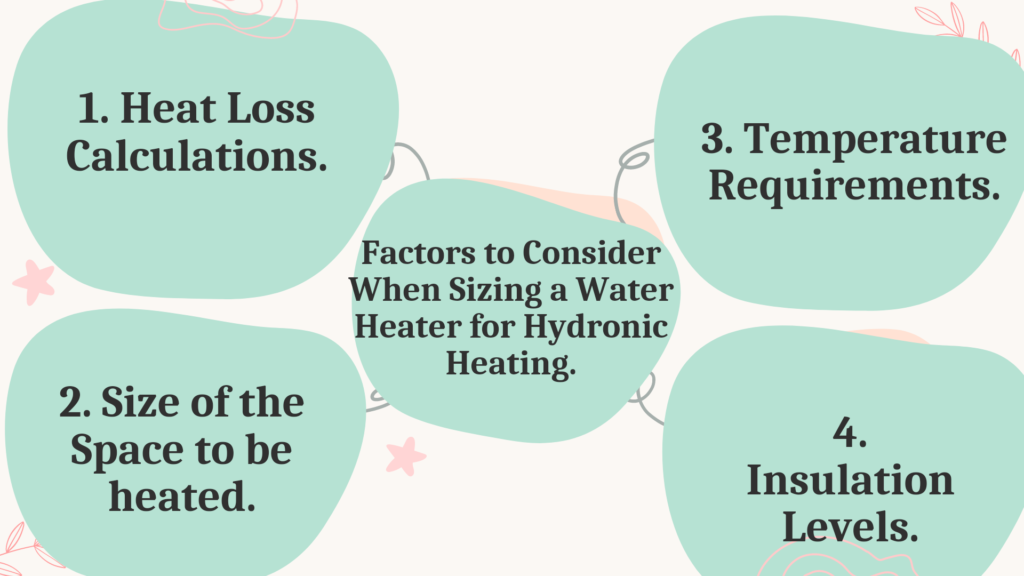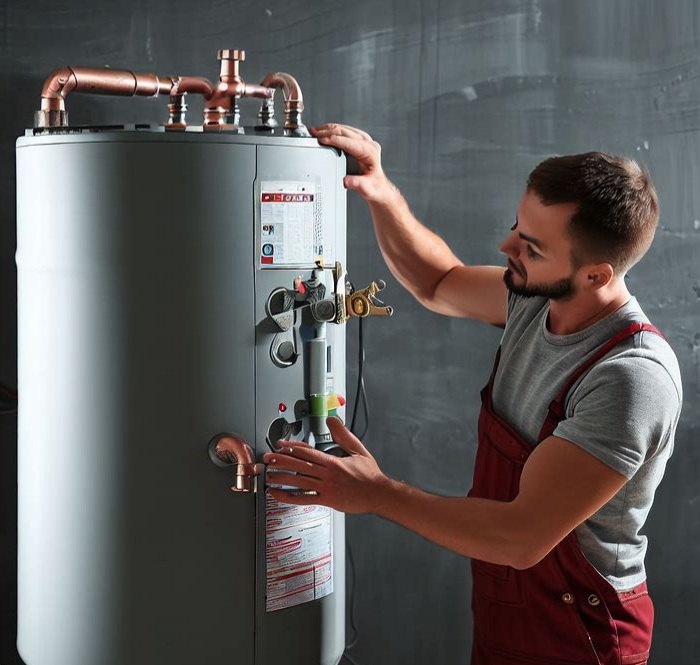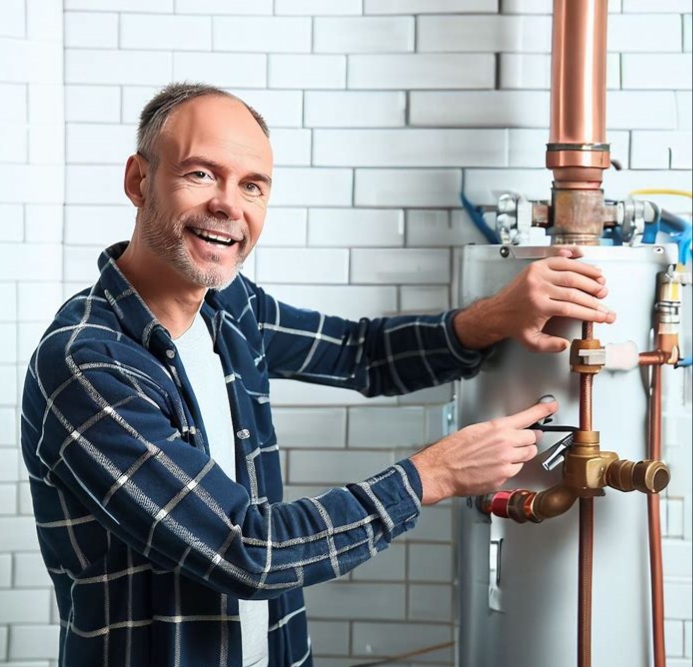Table of Contents
Are you unsure about the right size of water heater for your hydronic heating system? The wrong size could lead to inadequate heating and high energy bills. This comprehensive guide will provide clarity, walking you through crucial factors like heat loss calculations, space size, temperature requirements and more.
Dive in now to maximize your heating efficiency and save on those winter bills!
Key Takeaways
- Heat loss calculations are crucial in determining the right size water heater for hydronic heating, as they help estimate the amount of heat your system needs to replace.
- The size of the space to be heated is an important factor when sizing a water heater, with larger spaces requiring more heat output and thus a bigger water heater.
- Temperature requirements play a significant role in selecting the proper-sized water heater, as different applications have varying temperature needs that impact capacity requirements.
- Insulation levels should be considered when sizing a water heater for hydronic heating, as insufficient insulation can result in significant heat loss and higher energy consumption.
- When sizing tankless water heaters for hydronic heating, calculating flow rate requirements and checking compatibility with hydronic systems are crucial steps.
- Solar water heating systems must consider factors such as collector area needed, storage volume required, heat loss calculations, and system efficiency during sizing.
Factors to Consider When Sizing a Water Heater for Hydronic Heating

Calculating heat loss, determining the size of the space to be heated, specifying temperature requirements, and evaluating insulation levels are crucial considerations when sizing a water heater for hydronic heating.
Heat loss calculations
Understanding heat loss calculations plays a critical role in sizing your water heater for hydronic heating. Essentially, these calculations help you determine how much heat your space loses over time and thus, gives insight into the amount of heat your system needs to replace.
Begin by measuring the square footage of the area to be heated; this is an integral step towards determining the right size water heater for a radiant heating system. Then proceed to quantify heat loss via doors, windows, ceilings, and walls using specific industry-standard factors.
This calculated data allows you to accurately establish the correct capacity of water heater required for optimal functioning of your hydronic heating system.
Size of the space to be heated
For sizing a water heater for hydronic heating, one crucial factor to consider is the size of the space that needs to be heated. The square footage of the area plays a significant role in determining the appropriate size of the water heater.
A larger space will require more heat output and thus a bigger water heater, while a smaller space can be adequately heated with a smaller unit.
It’s important to note that different areas within a building may have varying insulation levels and temperature requirements. For instance, an insulated room may need less heat compared to an uninsulated garage or basement.
Taking these factors into account when sizing your water heater ensures optimal efficiency and performance.
To accurately determine the required water heater capacity, it’s advisable to consult heat loss calculations. These calculations take into consideration factors such as insulation levels, external temperature conditions, and desired indoor temperatures.
Temperature requirements
To properly size a water heater for hydronic heating, it’s important to consider the temperature requirements of the space you want to heat. The temperature you aim to achieve will determine the amount of heat energy needed from the water heater.
For example, if you’re looking for comfortable room temperatures, the water in your system may need to be heated between 70°F and 80°F. However, if you require higher temperatures for specialized applications like snow melting or industrial processes, then a higher temperature range might be necessary.
Keep in mind that increasing the desired temperature will impact the size and capacity requirements of your water heater. By understanding these specific temperature needs, you can accurately select a water heater that matches your hydronic heating demands while ensuring optimal comfort and performance.
Insulation levels
Insulation levels play a crucial role in properly sizing a water heater for hydronic heating. Insufficient insulation can result in significant heat loss, which means the water heater will have to work harder and consume more energy to maintain the desired temperature.
On the other hand, well-insulated spaces retain heat better, requiring less energy from the water heater. Therefore, it is important to assess and consider the insulation levels of the space being heated when determining the appropriate size of a water heater for hydronic heating.
This ensures that you select a water heater that can effectively meet your heating needs while optimizing energy efficiency. So, make sure to take into account insulation levels as you calculate and choose the right-sized water heater for your hydronic heating system.
Sizing a Water Heater for Radiant Heat Systems

When sizing a water heater for radiant heat systems, it’s important to determine the BTU/h requirements, consider the recovery rate, and select an appropriate tank size. Read on to learn more about properly sizing your water heater for efficient hydronic heating.
Determine the BTU/h requirements
To properly size a water heater for hydronic heating, it is crucial to determine the BTU/h (British Thermal Units per hour) requirements of your system. The BTU/h represents the amount of heat energy needed to raise the temperature of a pound of water by one degree Fahrenheit in an hour.
One way to calculate this requirement is by considering the square footage of the space you want to heat.
For example, if you have a 500-square-foot area that requires 30 BTU/h per square foot, you would multiply these two values together (500 x 30) to get a total of 15,000 BTU/h. This means your water heater should be capable of producing at least 15,000 BTU/h to adequately handle the heating needs of that particular space.
Consider the recovery rate
The recovery rate is an important factor to consider when sizing a water heater for hydronic heating. It refers to how quickly the water heater can heat up a new batch of water after it has been depleted.
A higher recovery rate means that the water heater can replenish hot water more quickly, ensuring a consistent supply for your radiant heat system. This is especially crucial during peak demand periods when multiple taps or fixtures are being used simultaneously.
By selecting a water heater with an appropriate recovery rate, you can ensure that your hydronic heating system operates efficiently and effectively, providing you with the comfort and warmth you desire.
Select the appropriate tank size
One crucial aspect of sizing a water heater for hydronic heating is selecting the appropriate tank size. The tank size determines how much hot water can be stored and used at any given time.
To ensure you choose the right tank size, consider factors such as the number of family members or occupants, their specific requirements, and the usage patterns. For residential use, it’s essential to account for the number of individuals in a family to meet their hot water demands adequately.
Commercial applications may require utilizing a water heater size calculator to determine an optimal tank size based on square footage and other variables. Remember that buying a bigger tank doesn’t always mean better; choosing the correct tank size will guarantee efficient operation without unnecessary costs or waste of energy resources.
Sizing Tankless Water Heaters for Hydronic Heating

To size tankless water heaters for hydronic heating, calculate the flow rate requirements, check for compatibility with hydronic systems, and consider the maximum temperature rise.
Calculate the flow rate requirements
To properly size a water heater for hydronic heating, it’s important to calculate the flow rate requirements. The flow rate refers to the amount of hot water needed at any given time to meet the demands of your heating system.
This calculation is crucial in ensuring that your water heater can deliver enough hot water efficiently and effectively.
To calculate the flow rate requirements, you need to consider factors such as the size of your radiant heat system and its specific needs. For example, if you have a larger space or multiple zones that need heating, you may require a higher flow rate compared to a smaller area.
Another factor to consider is the temperature rise required by your system. Different radiant heat systems have varying temperature needs, so it’s essential to calculate how much the temperature needs to be raised based on incoming cold water supply.
By accurately calculating these flow rate requirements, you can ensure that your hydronic heating system is adequately sized with the right water heater capacity. This will not only provide optimal comfort but also help improve energy efficiency and overall performance.
Check for compatibility with hydronic heating systems
Before purchasing a tankless water heater for your hydronic heating system, it’s important to ensure compatibility. Not all tankless water heaters are designed to work with hydronic heating systems, so checking for compatibility is crucial.
Tankless water heaters that are specifically designed for hydronic heating have features and controls that optimize performance and efficiency in this type of system. By selecting a compatible unit, you can maximize the benefits of your hydronic heating system while avoiding any potential issues or inefficiencies.
Make sure to consult with a professional or refer to the manufacturer’s specifications to determine if a specific tankless water heater is suitable for use with your hydronic heating setup.
Consider the maximum temperature rise
When sizing a water heater for hydronic heating, it is crucial to consider the maximum temperature rise. This refers to the difference between the desired supply temperature and the incoming cold water temperature.
The larger the temperature rise required, the higher capacity water heater you will need. For example, if you are aiming for a 50-degree Fahrenheit temperature rise in your system and your incoming cold water temperature is 40 degrees Fahrenheit, you would need a water heater with a minimum output of 90 degrees Fahrenheit.
Understanding this factor ensures that your chosen water heater can deliver the necessary level of heat for your hydronic heating system efficiently and effectively.
Sizing Solar Water Heating Systems for Hydronic Heating
To size solar water heating systems for hydronic heating, you need to calculate the collector area needed and determine the storage volume required. Additionally, other calculations such as heat loss and system efficiency should be taken into consideration.
Calculate the collector area needed
To properly size a solar water heating system for hydronic heating, it is crucial to calculate the collector area needed. This will help ensure that the system can efficiently meet your heating requirements. Here are the steps to calculate the required collector area:
- Determine the heat load: Calculate the total heat load of your space by considering factors such as insulation levels, desired indoor temperature, and geographical location.
- Estimate solar resource availability: Research the average solar radiation in your area to estimate how much energy can be collected from the sun.
- Calculate panel efficiency: Determine the efficiency of your selected solar panels by reviewing their specifications or consulting with a professional.
- Determine useful energy delivery: Multiply the heat load by a correction factor that accounts for system inefficiencies and losses.
- Calculate collector area: Divide the useful energy delivery by (solar resource availability × panel efficiency) to obtain the required collector area.
- Multiply 50,000 BTU/hr by a correction factor (e.g., 0.8) to account for system losses.
- Convert BTU to kilowatt – hours (kWh) by dividing by 3,412 (conversion factor).
- Divide this value by (5 kWh/m²/day × 0.75) to determine the required collector area in square meters.
Determine the storage volume required
To properly size a water heater for hydronic heating, you need to determine the storage volume required. This will ensure that your system can meet the heating demands of your space effectively. Here’s how you can calculate the storage volume:
- Calculate the total heat load: Determine the total heat load by considering factors like the square footage of the space, insulation levels, and temperature requirements. Use heat loss calculations to determine how much heat is needed to maintain a comfortable temperature.
- Estimate the heating time: Estimate how long you want your water heater to run continuously during peak heating periods. For example, if you want your water heater to run for 8 hours continuously during cold winter nights, multiply the total heat load by 8.
- Determine the required storage capacity: Divide the estimated heating time by 60 (minutes) to convert it into hours. Multiply this value by the total heat load calculated in step 1. This will give you an estimate of how much hot water storage capacity you need in gallons.
- Consider system efficiency: It’s important to factor in system efficiency when determining storage volume requirements. Different types of water heaters have different efficiencies, so make sure to consider this when selecting and sizing your water heater.
- Consult a professional: If you’re unsure about any step in determining storage volume or feel overwhelmed with calculations, it’s always best to consult a professional installer or an HVAC engineer who can guide you through the process.
Consider other calculations such as heat loss and system efficiency
To properly size a water heater for hydronic heating, it’s important to take into account other calculations such as heat loss and system efficiency. These factors can greatly impact the overall performance and effectiveness of your heating system. Here are some key considerations:
- Heat loss calculations: It’s crucial to determine the amount of heat that your space will lose during colder months. This helps you accurately size the water heater to meet the heating demands without wasting energy or experiencing temperature fluctuations.
- System efficiency: Assessing the efficiency of your hydronic heating system is essential in determining the appropriate water heater size. Higher efficiency systems require less energy, which can influence the capacity needed for optimal performance.
- Insulation levels: Adequate insulation plays a significant role in minimizing heat loss and maximizing energy efficiency. By assessing your insulation levels, you can ensure that your water heater is properly sized to compensate for any potential heat loss due to poor insulation.
- Recovery rate: The recovery rate refers to how quickly a water heater can replenish hot water after usage. Consider this factor when sizing a water heater, as it determines its ability to meet the demand for hot water during peak periods efficiently.
- Temperature requirements: Determine the desired temperature range for your hydronic heating system. Higher temperature requirements typically require larger capacity water heaters to meet these demands effectively.
FAQs
1. Why is it important to properly size a water heater for hydronic heating?
Properly sizing a water heater for hydronic heating ensures that the system will be able to meet the demands of your home or building, providing sufficient hot water and maintaining optimal efficiency.
2. How can I determine the appropriate size of a water heater for my hydronic heating system?
Determining the appropriate size of a water heater for your hydronic heating system involves considering factors such as the square footage of your space, the number of rooms or zones being heated, and anticipated hot water usage.
3. What are some consequences of undersizing a water heater for hydronic heating?
Undersizing a water heater for hydronic heating can lead to insufficient hot water supply, inadequate heat output, and increased energy consumption as the system works harder to compensate for its limitations.
4. Can oversizing a water heater cause any issues with hydronic heating systems?
While oversizing may seem like it would provide excess capacity, it can actually result in inefficiencies and contribute to higher energy bills. Oversized heaters may short cycle more frequently, leading to unnecessary wear and tear on components and potentially compromising comfort levels in your space.
Conclusion
In conclusion, properly sizing a water heater for hydronic heating is essential to ensure optimal performance and energy efficiency. By considering factors such as heat loss calculations, space size, temperature requirements, and insulation levels, you can determine the appropriate tank size or flow rate needed for your specific system.
Whether it’s a traditional storage water heater, a tankless option, or even a solar water heating system, taking the time to accurately size your water heater will result in long-lasting comfort and cost savings.
Don’t guess when it comes to sizing – follow these guidelines for success!
Source URLs
